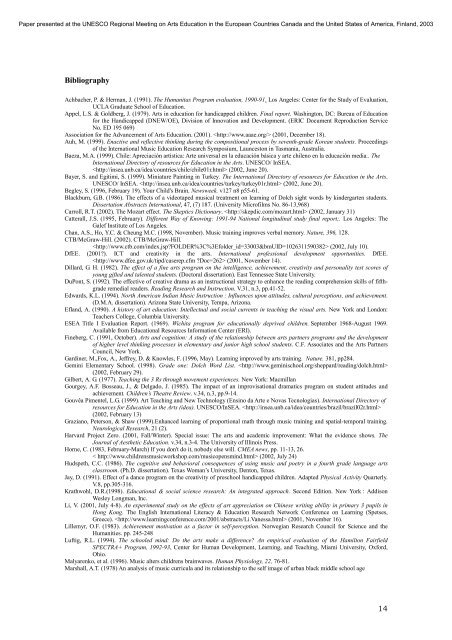The Contribution of Arts Education to Children's Lives - Unesco
The Contribution of Arts Education to Children's Lives - Unesco
The Contribution of Arts Education to Children's Lives - Unesco
Create successful ePaper yourself
Turn your PDF publications into a flip-book with our unique Google optimized e-Paper software.
Paper presented at the UNESCO Regional Meeting on <strong>Arts</strong> <strong>Education</strong> in the European Countries Canada and the United States <strong>of</strong> America, Finland, 2003<br />
Bibliography<br />
Achbacher, P. & Herman, J. (1991). <strong>The</strong> Humanitas Program evaluation, 1990-91. Los Angeles: Center for the Study <strong>of</strong> Evaluation,<br />
UCLA Graduate School <strong>of</strong> <strong>Education</strong>.<br />
Appel, L.S. & Goldberg, J. (1979). <strong>Arts</strong> in education for handicapped children. Final report. Washing<strong>to</strong>n, DC: Bureau <strong>of</strong> <strong>Education</strong><br />
for the Handicapped (DNEW/OE), Division <strong>of</strong> Innovation and Development. (ERIC Document Reproduction Service<br />
No. ED 195 069)<br />
Association for the Advancement <strong>of</strong> <strong>Arts</strong> <strong>Education</strong>. (2001). (2001, December 18).<br />
Auh, M. (1999). Enactive and reflective thinking during the compositional process by seventh-grade Korean students. Proceedings<br />
<strong>of</strong> the International Music <strong>Education</strong> Research Symposium, Launces<strong>to</strong>n in Tasmania, Australia.<br />
Baeza, M.A. (1999). Chile: Apreciación artística: Arte universal en la educación básica y arte chileno en la educación media.. <strong>The</strong><br />
International Direc<strong>to</strong>ry <strong>of</strong> resources for <strong>Education</strong> in the <strong>Arts</strong>. UNESCO/ InSEA.<br />
(2002, June 20).<br />
Bayer, S. and Egitimi, S. (1999). Miniature Painting in Turkey. <strong>The</strong> International Direc<strong>to</strong>ry <strong>of</strong> resources for <strong>Education</strong> in the <strong>Arts</strong>.<br />
UNESCO/ InSEA. (2002, June 20).<br />
Begley, S. (1996, February 19). Your Child's Brain. Newsweek. v127 n8 p55-61.<br />
Blackburn, G.B. (1986). <strong>The</strong> effects <strong>of</strong> a videotaped musical treatment on learning <strong>of</strong> Dolch sight words by kindergarten students.<br />
Dissertation Abstracts International, 47, (7) 187. (University Micr<strong>of</strong>ilms No. 86-13,968)<br />
Carroll, R.T. (2002). <strong>The</strong> Mozart effect. <strong>The</strong> Skeptics Dictionary. (2002, January 31)<br />
Catterall, J.S. (1995, February). Different Way <strong>of</strong> Knowing: 1991-94 National longitudinal study final report;. Los Angeles: <strong>The</strong><br />
Galef Institute <strong>of</strong> Los Angeles.<br />
Chan, A.S., Ho, Y.C. & Cheung M.C. (1998, November). Music training improves verbal memory. Nature, 396, 128.<br />
CTB/McGraw-Hill. (2002). CTB/McGraw-Hill.<br />
(2002, July 10).<br />
DfEE. (2001?). ICT and creativity in the arts. International pr<strong>of</strong>essional development opportunities. DfEE.<br />
(2001, November 14).<br />
Dillard, G. H. (1982). <strong>The</strong> effect <strong>of</strong> a fine arts program on the intelligence, achievement, creativity and personality test scores <strong>of</strong><br />
young gifted and talented students. (Doc<strong>to</strong>ral dissertation). East Tennessee State University.<br />
DuPont, S. (1992). <strong>The</strong> effective <strong>of</strong> creative drama as an instructional strategy <strong>to</strong> enhance the reading comprehension skills <strong>of</strong> fifthgrade<br />
remedial readers. Reading Research and Instruction. V.31, n.3, pp.41-52.<br />
Edwards, K.L. (1994). North American Indian Music Instruction : Influences upon attitudes, cultural perceptions, and achievement.<br />
(D.M.A. dissertation). Arizona State University, Tempa, Arizona.<br />
Efland, A. (1990). A his<strong>to</strong>ry <strong>of</strong> art education: Intellectual and social currents in teaching the visual arts. New York and London:<br />
Teachers College, Columbia University.<br />
ESEA Title I Evaluation Report. (1969). Wichita program for educationally deprived children. September 1968-August 1969.<br />
Available from <strong>Education</strong>al Resources Information Center (ERI).<br />
Fineberg, C. (1991, Oc<strong>to</strong>ber). <strong>Arts</strong> and cognition: A study <strong>of</strong> the relationship between arts partners programs and the development<br />
<strong>of</strong> higher level thinking processes in elementary and junior high school students. C.F. Associates and the <strong>Arts</strong> Partners<br />
Council, New York.<br />
Gardiner, M.,Fox, A., Jeffrey, D. & Knowles, F. (1996, May). Learning improved by arts training. Nature. 381, pp284.<br />
Gemini Elementary School. (1998). Grade one: Dolch Word List. <br />
(2002, February 29).<br />
Gilbert, A. G. (1977). Teaching the 3 Rs through movement experiences. New York: Macmillan<br />
Gourgey, A.F. Bosseau, J., & Delgado, J. (1985). <strong>The</strong> impact <strong>of</strong> an improvisational dramatics program on student attitudes and<br />
achievement. Children’s <strong>The</strong>atre Review. v.34, n.3, pp.9-14.<br />
Gouvêa Pimentel, L.G. (1999). Art Teaching and New Technology (Ensino da Arte e Novas Tecnologias). International Direc<strong>to</strong>ry <strong>of</strong><br />
resources for <strong>Education</strong> in the <strong>Arts</strong> (idea). UNESCO/InSEA. <br />
(2002, February 13)<br />
Graziano, Peterson, & Shaw (1999).Enhanced learning <strong>of</strong> proportional math through music training and spatial-temporal training.<br />
Neurological Research, 21 (2).<br />
Harvard Project Zero. (2001, Fall/Winter). Special issue: <strong>The</strong> arts and academic improvement: What the evidence shows. <strong>The</strong><br />
Journal <strong>of</strong> Aesthetic <strong>Education</strong>. v.34, n.3-4. <strong>The</strong> University <strong>of</strong> Illinois Press.<br />
Horne, C. (1983, February-March) If you don't do it, nobody else will. CMEA news, pp. 11-13, 26.<br />
< http://www.childrensmusicworkshop.com/musicopensmind.html> (2002, July 24)<br />
Hudspeth, C.C. (1986). <strong>The</strong> cognitive and behavioral consequences <strong>of</strong> using music and poetry in a fourth grade language arts<br />
classroom. (Ph.D. dissertation). Texas Woman’s University, Den<strong>to</strong>n, Texas.<br />
Jay, D. (1991). Effect <strong>of</strong> a dance program on the creativity <strong>of</strong> preschool handicapped children. Adapted Physical Activity Quarterly.<br />
V.8, pp.305-316.<br />
Krathwohl, D.R.(1998). <strong>Education</strong>al & social science research: An integrated approach. Second Edition. New York : Addison<br />
Wesley Longman, Inc.<br />
Li, V. (2001, July 4-8). An experimental study on the effects <strong>of</strong> art appreciation on Chinese writing ability in primary 3 pupils in<br />
Hong Kong. <strong>The</strong> English International Literacy & <strong>Education</strong> Research Network Conference on Learning (Spetses,<br />
Greece). (2001, November 16).<br />
Lillemyr, O.F. (1983). Achievement motivation as a fac<strong>to</strong>r in self-perception. Norwegian Research Council for Science and the<br />
Humanities. pp. 245-248<br />
Luftig, R.L. (1994). <strong>The</strong> schooled mind: Do the arts make a difference? An empirical evaluation <strong>of</strong> the Hamil<strong>to</strong>n Fairfield<br />
SPECTRA+ Program, 1992-93, Center for Human Development, Learning, and Teaching, Miami University, Oxford,<br />
Ohio.<br />
Malyarenko, et al. (1996). Music alters childrens brainwaves. Human Physiology, 22, 76-81.<br />
Marshall, A.T. (1978) An analysis <strong>of</strong> music curricula and its relationship <strong>to</strong> the self image <strong>of</strong> urban black middle school age<br />
14

















